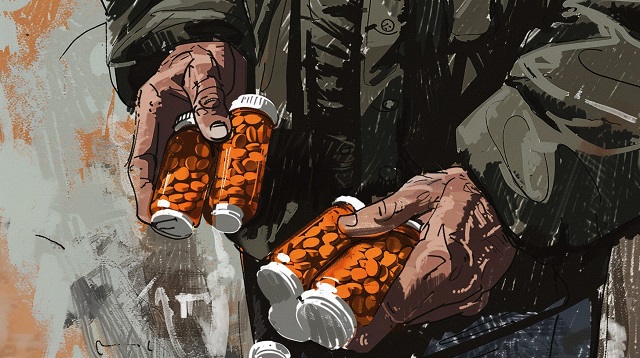National
Conservative candidate says he’s been booted for opposition to mandated vaccinations and vaccine passports

Jonas J. Smith Disallowed as Conservative Party of Canada Candidate for the Yukon
Addictions
Canada’s ‘safer supply’ patients are receiving staggering amounts of narcotics

Image courtesy of Midjourney.
|
|
How a Small Population Fuels a Black Market Epidemic, Echoing Troubling Parallels in Sweden
A significant amount of safer supply opioids are obviously being diverted to the black market, but some influential voices are vehemently downplaying this problem. They often claim that there are simply too few safer supply clients for diversion to be a real issue – but this argument is misleading because it glosses over the fact that these clients receive truly staggering amounts of narcotics relative to everyone else.
“Safer supply” refers to the practice of prescribing free recreational drugs as an alternative to potentially-tainted street substances. In Canada, that typically means distributing eight-mg tablets of hydromorphone, an opioid as potent as heroin, to mitigate the use of illicit fentanyl.
There is clear evidence that most safer supply clients regularly sell or trade almost all of their hydromorphone tablets for stronger illicit substances, and that this is flooding communities with the drug and fuelling new addictions and relapses. Just five years ago, the street price of an eight-mg hydromorphone tablet was around $20 in major Canadian cities – now they often go for as little as $1.
But advocates repeatedly emphasize that, even if such diversion is occurring, it must be a minor issue because there are only a few thousand safer supply clients in Canada. They believe that it is simply impossible for such a small population to have a meaningful impact on the overall black market for diverted pharmaceuticals, and that the sudden collapse of hydromorphone prices must have been caused by other factors.
This is an earnest belief – but an extremely ill-informed one.
It is difficult to analyze safer supply at the national level, as each province publishes different drug statistics that make interprovincial comparisons near-impossible. So, for the sake of clarity, let’s focus primarily on B.C., where the debate over safer supply has raged hottest.
According to a dashboard published by the British Columbia Centre for Disease Control, there were only 4,450 safer supply clients in the province in December 2023, of which 4,250 received opioids. In contrast, the 2018/19 British Columbia Controlled Prescription Drug Atlas (more recent data is unavailable) states that there were approximately 80,000 hydromorphone patients in the province that year – a number that is unlikely to have decreased significantly since then.
We can thus reasonably assume that safer supply clients represent around 5 per cent of the province’s total hydromorphone patients – but if so few people are on safer supply, how could they have a profound impact on the black market? The answer is simple: these clients receive astonishing sums of the drug, and divert at an unparalleled level, compared to everyone else.
Safer supply clients generally receive 4-8 eight-mg tablets per day at first, but almost all of them are quickly moved up to higher doses. In B.C., most patients are kept at 14 tablets (112-mg in total) per day, which is the maximum allowed by the province’s guidelines. For comparison, patients in Ontario can receive as many as 30 tablets a day (240-mg in total).
These are huge amounts.
The typical hydromorphone dose used to treat post-surgery pain in hospital settings is two-mg every 4-6 hours – or roughly 12-mg per day. So that means that safer supply clients can receive roughly 10-20 times the daily dose given to acute pain patients, depending on which province they’re located in. And while acute pain patients are tapered off hydromorphone after a few weeks, safer supply clients receive their tablets indefinitely.
Some chronic pain patients (i.e. people struggling with severe arthritis) are also prescribed hydromorphone – but, in most cases, their daily dose is 12-mg or less. The exception here is terminally ill cancer patients, who may receive up to around 100-mg of hydromorphone per day. However, this population is relatively small, so we once again have a situation where safer supply patients are, for the most part, receiving much more hydromorphone than their peers.
Not only do safer supply patients receive incredible amounts of the drug, they also seem to divert it at much higher rates – which is a frequently overlooked factor.
The clandestine nature of prescription drug diversion makes it near-impossible to measure, but a 2017 peer-reviewed study estimated that, in the United States, up to 3 per cent of all prescription opioids end up on the black market.
In contrast, it appears that safer supply patients divert 80-90 per cent of their hydromorphone.
These numbers should be taken with a grain of salt, as there have been no attempts to measure safer supply diversion – harm reduction researchers tend to simply ignore the problem, which means that we must rely on journalistic evidence that is necessarily anecdotal in nature. While this evidence has its limits, it can, at the very least, illustrate the rough scale of the problem.
For example, in London, Ontario, I interviewed six former drug users last summer who said that, of the safer supply clients they knew, 80 per cent sold almost all of their hydromorphone – just one interviewee placed the number closer to 50 per cent. More recently, I interviewed an addiction outreach worker in Ottawa who estimated that 90 per cent of safer supply clients diverted their drugs. These numbers are consistent with the testimony of dozens of addiction physicians who have said that safer supply diversion is ubiquitous.
Let us take a conservative estimate and imagine that only 30 per cent of safer supply hydromorphone is diverted – even this would be potentially catastrophic.
So we can see why any serious attempt to discuss safer supply diversion cannot narrowly focus on patient numbers – to ignore differences in doses and diversion rates is inexcusably misleading.
But we don’t need to rely on theory to make this point, because the recent parliamentary testimony of Fiona Wilson, who is deputy chief of the Vancouver Police Department and president of the B.C. Association of Chiefs of Police (BCACP), illustrates the situation quite neatly.
Wilson testified to the House of Commons health committee earlier this month that half of the hydromorphone recently seized in B.C. can be attributed to safer supply. As she did not specify whether the other half was attributed to other sources, or simply of indeterminate origin, the actual rate of safer supply hydromorphone seizures may actually be even higher.
As, once again, safer supply clients constitute roughly 5 per cent of the total hydromorphone patient population, Wilson’s testimony suggests that, on a per capita basis, safer supply patients divert at least 18 times more of the drug than everyone else.
This is exactly what one would expect to find given our earlier analysis, and these facts, by themselves, repudiate the argument that safer supply diversion is insignificant. When a small population is at least doubling the street supply of a dangerous pharmaceutical opioid, this is a problem.
The fact that so few people can cause substantial, system-wide harm is not unprecedented. In fact, this exact same problem was observed in Sweden, which, from 1965-1967, experimented with a model of safer supply that closely resembled what is being done in Canada today. A small number of patients – barely more than a hundred – were given near-unlimited access to free recreational drugs under the assumption that this would keep them “safe.”
But these patients simply sold the bulk of their drugs, which caused addiction and crime rates to skyrocket across Stockholm. Commentators at the time referred to safer supply as “the worst scandal in Swedish medical history,” and, even today, the experiment remains a cautionary tale among the country’s drug researchers.
It is simply wrong to say that there are too few safer supply clients to cause a diversion crisis. People who make this claim are ignorant of contemporary and historical facts, and those who wish to position themselves as drug experts should be mindful of this, lest they mislead the public about a destructive drug crisis.
This article was originally published in The Bureau, a Canadian publication devoted to using investigative journalism to tackle corruption and foreign influence campaigns. You can find this article on their website here.
Economy
Ottawa’s homebuilding plans might discourage much-needed business investment

From the Fraser Institute
In the minds of most Canadians, there’s little connection between housing affordability and productivity growth, a somewhat wonky term used mainly by economists. But in fact, the connection is very real.
To improve affordability, the Trudeau government recently announced various financing programs to encourage more investment in residential housing including $6 billion for the Canada Housing Infrastructure Fund and $15 billion for an apartment construction loan program.
Meanwhile, Carolyn Rogers, senior deputy governor of the Bank of Canada, recently said weak business investment is contributing to Canada’s weak growth in productivity (essentially the value of economic output per hour of work). Therefore, business investment to promote productivity growth and income growth for workers is also an economic priority.
But here’s the problem. There’s only so much financial capital at reasonable interest rates to go around.
Because Canada is a small open economy, it might seem that Canadian investors have unlimited access to offshore financial capital, but this is not true. Foreign lenders and investors incur foreign exchange risk when investing in Canadian-dollar denominated assets, and the risk that Canadian asset values will decline in real value. Suppliers of financial capital expect to receive higher yields on their investments for taking on more risk. Hence, investment in residential housing (which the Trudeau government wants to promote) and investment in business assets (which the Bank of Canada warns is weak) compete against each other for scarce financial capital supplied by both domestic and foreign savers.
For perspective, investment in residential housing as a share of total investment increased from 22.4 per cent in 2000 to 41.3 per cent in 2021. Over the same period, investment in two asset categories critical to improving productivity—information and communications equipment and intellectual property products including computer software—decreased from 30.3 per cent of total domestic investment in 2000 to 22.7 per cent in 2021.
What are the potential solutions?
Of course, more financial capital might be available at existing interest rates for domestic investment in residential housing and productivity-enhancing business assets if investment growth declines in other asset categories such as transportation, roads and hospitals. But these assets also contribute to improved productivity and living standards.
Regulatory and legal pressures on Canadian pension funds to invest more in Canada and less abroad would also free up domestic savings for increased investments in residential housing, machinery and equipment and intellectual property products. But this amounts to an implicit tax on Canadians with domestic pension fund holdings to subsidize other investors.
Alternatively, to increase domestic savings, governments in Canada could increase consumption taxes (e.g. sales taxes) while reducing or even eliminating capital gains taxes, which reduce the after-tax expected returns to investing in businesses, particularly riskier new and emerging domestic companies. (Although according to the recent federal budget, the Trudeau government plans to increase capital gains taxes.)
Or governments could reduce the regulatory burden on private-sector businesses, especially small and medium-sized enterprises, so financial capital and other inputs used to comply with often duplicative or excessive regulation can be used to invest in productivity-enhancing assets. And governments could eliminate restrictions on foreign investment in large parts of the Canadian economy including telecommunications, banking and transportation. By increasing competition, governments can improve productivity.
Eliminating such restrictions would also arguably increase the supply of foreign financial capital flowing into Canada to the extent that large foreign investors would prefer to manage their Canadian assets rather than take portfolio investment positions in Canadian-owned companies.
Canadians would undoubtedly benefit from increases in housing construction (and subsequently, increased affordability) and improved productivity from increased business investment. However, government subsidies to home builders, including the billions recently announced by the Trudeau government, simply move available domestic savings from one set of investments to another. The policy goal should be to increase the availability of risk-taking financial capital so the costs of capital decrease for Canadian investors.
Author:
-

 Economy2 days ago
Economy2 days ago‘Gambling With The Grid’: New Data Highlights Achilles’ Heel Of One Of Biden’s Favorite Green Power Sources
-

 Energy2 days ago
Energy2 days agoMarket Realities Are Throwing Wrench In Biden’s Green Energy Dreams
-

 ESG2 days ago
ESG2 days agoTennessee Taking Lead In Protecting Civil Rights And Free Enterprise—And Stopping Political Debanking
-

 Brownstone Institute1 day ago
Brownstone Institute1 day agoBook Burning Goes Digital
-

 conflict1 day ago
conflict1 day agoOver 200 Days Into War, Family Of American Hostage in Gaza Strives For Deal To Bring Son Home
-

 Brownstone Institute13 hours ago
Brownstone Institute13 hours agoThe Predictable Wastes of Covid Relief
-

 Addictions4 hours ago
Addictions4 hours agoCanada’s ‘safer supply’ patients are receiving staggering amounts of narcotics
-

 Alberta4 hours ago
Alberta4 hours agoGame changer: Trans Mountain pipeline expansion complete and starting to flow Canada’s oil to the world







